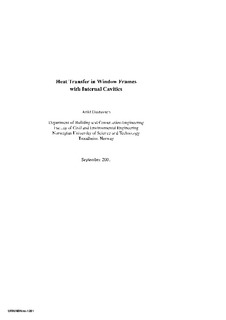| dc.contributor.author | Gustavsen, Arild | nb_NO |
| dc.date.accessioned | 2014-12-19T11:24:51Z | |
| dc.date.available | 2014-12-19T11:24:51Z | |
| dc.date.created | 2001-11-12 | nb_NO |
| dc.date.issued | 2001 | nb_NO |
| dc.identifier | 125277 | nb_NO |
| dc.identifier.isbn | 82-471-5351-3 | nb_NO |
| dc.identifier.uri | http://hdl.handle.net/11250/231238 | |
| dc.description.abstract | Heat transfer in window frames with internal air cavities is studied in this thesis. Investigations focus on two- and three-dimensional natural convection effects inside air cavities, the dependence of the emissivity on the thermal transmittance, and the emissivity of anodized and untreated aluminum profiles. The investigations are mostly conducted on window frames which are the same size as real frames found in residential buildings.
Numerical and experimental investigations were performed to study the effectiveness of one commercial Computational Fluid Dynamics (CFD) program for simulating combined natural convection and heat transfer in simple three-dimensional window frames with internal air cavities. The accuracy of the conjugate CFD simulations was evaluated by comparing results for surface temperature on the warm side of the specimens to results from experiments that use infrared (IR) thermography to map surface temperatures during steady-state thermal tests. In general, there was good agreement between the simulations and experiments.
Two-dimensional computational fluid dynamics and conduction simulations are performed to study the difference between treating air cavities as a fluid and as a solid when calculating the thermal transmittance of window frames. The simulations show that traditional software codes, simulating only conduction and using equivalent conductivities for the air cavities, give U- values that compare well with results from fluid flow simulations. The difference between the two models are mostly limited to the temperature distribution inside air cavities. It is also found that cavities with an interconnection less than about 7 mm can be treated as separate cavities.
Three-dimensional natural convection effects in simple and custom-made PVC and thermally broken aluminum window frames with one open internal cavity were studied, with the use of CFD simulations and thermography experiments. Focus was put on corner effects and heat transfer rates. From the results it appears that the thermal transmittance of a four-sided section can be found by calculating the average of the thermal transmittance of the respective single horizontal and vertical sections. In addition, it was found that two-dimensinal conduction heat transfer simulation software agrees well with tree-dimensional CFD simulations if the natural convection correlations used for the internal cavities are correct.
Numerical studies were done with natural convection in three-dimensional cavities with a high vertical aspect ratio and a low horizontal aspect ratio. The cavities studied had vertical aspect ratios of 20, 40, and 80 and horizontal aspect ratios ranging from 0,2 to 5. It was shown that three-dimensional cavities with a horizontal aspect ratio larger than five can be considered to be a two-dimensional cavity to within 4 % when considering heat transfer rates. Nusselt number correlations for the different horizontal aspect ratios are presented for cavities with vertical aspect ratios of 20 and 40. Complex multicellular flow was studied for the case where the vertical and horizontal aspect ratios were 40 and 2, respectively.
Experimental studies included the normal spectral and total emissivity of specimens from six meter long untreated and anodized aluminum profiles. Specimens facing the internal cavities (thermal break cavity and all aluminum cavity) were measured. Some masking tapes often used in hot box experiments were also measured. The normal total emissivity was found to be is fairly constant (between 0.834 and 0.856) for exterior parts of the anodized profile and for surfaces facing the thermal break cavity. The normal total emissivity of the all-aluminum internal cavities was found to vary between 0.055 and 0.82. The experiments were performed with a Fourier transform infrared spectrometer in the wavelength interval from 4.5 to 40 μm. | nb_NO |
| dc.language | eng | nb_NO |
| dc.publisher | Fakultet for ingeniørvitenskap og teknologi | nb_NO |
| dc.relation.ispartofseries | Dr.ingeniøravhandling, 0809-103X; 2001:86 | nb_NO |
| dc.relation.haspart | Gustavsen, A; Griffith, BT; Arasteh, D. Three-Dimensional Conjugate Computational Fluid Dynamics Simulations of Internal Window Frame Cavities Validated Using Infrared Thermography. ASHRAE Transactions. 107(2), 2001. | nb_NO |
| dc.relation.haspart | Gustavsen, A; Griffith, BT; Arasteh, D. Natural Convection Effects in Three-Dimensional Windows Frames with Internal Cavities. ASHRAE Transactions. 107(2), 2001. | nb_NO |
| dc.relation.haspart | Gustavsen, A; Berdahl, P. Spectral Emissivity of Anodized Aluminum and the Thermal Transmittance of Aluminum Window Frames. Nordic Journal of Building Physics. 3, 2003. | nb_NO |
| dc.subject | | en_GB |
| dc.subject | Byggnadsteknik | en_GB |
| dc.subject | | en_GB |
| dc.subject | Samhällsbyggnadsteknik och arkitektur | en_GB |
| dc.subject | TECHNOLOGY: Civil engineering and architecture: Building engineering | en_GB |
| dc.title | Heat transfer in window frames with internal cavities | nb_NO |
| dc.type | Doctoral thesis | nb_NO |
| dc.source.pagenumber | 92 | nb_NO |
| dc.contributor.department | Norges teknisk-naturvitenskapelige universitet, Fakultet for ingeniørvitenskap og teknologi | nb_NO |
| dc.description.degree | dr.ing. | nb_NO |
| dc.description.degree | dr.ing. | en_GB |
